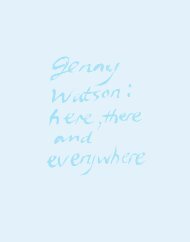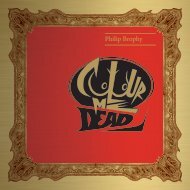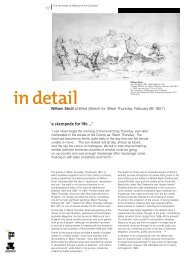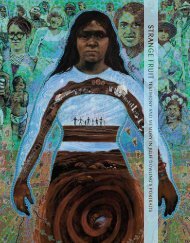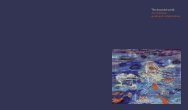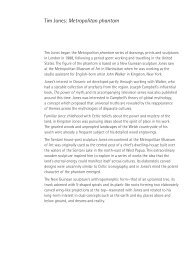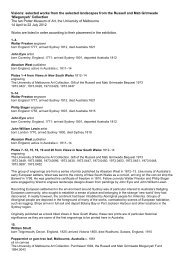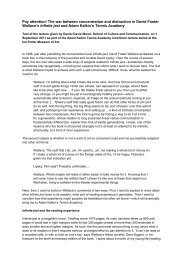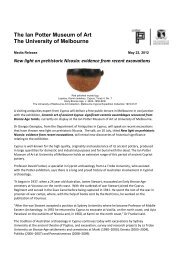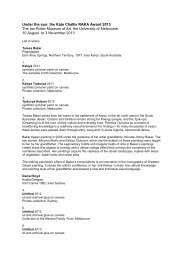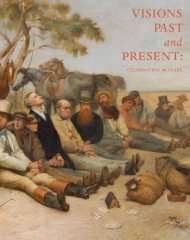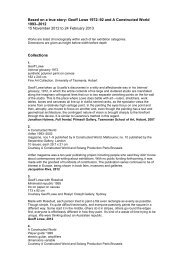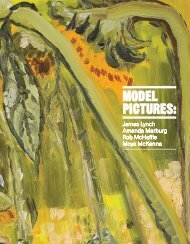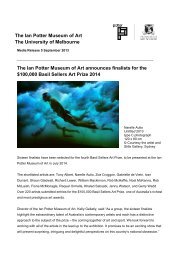The body the ruin
Catalogue - Ian Potter Museum of Art - University of Melbourne
Catalogue - Ian Potter Museum of Art - University of Melbourne
You also want an ePaper? Increase the reach of your titles
YUMPU automatically turns print PDFs into web optimized ePapers that Google loves.
{<br />
<strong>The</strong> material of <strong>the</strong> actor’s art is <strong>the</strong> human <strong>body</strong>, i.e. <strong>the</strong> torso, <strong>the</strong><br />
limbs, <strong>the</strong> head and <strong>the</strong> voice. While studying his material, <strong>the</strong> actor<br />
should not rely upon <strong>the</strong> anatomy, but upon <strong>the</strong> possibilities of his<br />
<strong>body</strong>, as a material for stage performance.<br />
And again <strong>the</strong>re is a tension here between <strong>the</strong> unified collective<br />
language of gesture and <strong>the</strong> audience group reaction to <strong>the</strong>se<br />
gestures, and <strong>the</strong> individual understanding (as in ‘feel’ or ‘be<br />
conscious of’) of <strong>the</strong> <strong>body</strong> both as a mechanical entity and also as a<br />
thing that feels and expresses itself as an active protagonist in <strong>the</strong><br />
construction of meaning and sensation. Gilles Deleuze, for example,<br />
describes <strong>the</strong> <strong>body</strong> as having a language of its own and being able<br />
to ‘speak’, and <strong>the</strong>refore having a subjectivity of its own (ra<strong>the</strong>r than<br />
simply serving <strong>the</strong> mind). 3<br />
‡<br />
Christian Capurro<br />
On being and being done with (detail) 2005<br />
steel table, magazines, rubber erasings, metal ruler, lamp,<br />
correction fluid pens, pencils, erasers, scalpel, paper<br />
dimensions variable<br />
Courtesy <strong>the</strong> artist<br />
<strong>the</strong> forced coordination of four to five bodies, and, like <strong>the</strong> modernist<br />
references in Maclennan’s work, this is a case of <strong>the</strong> individual <strong>body</strong><br />
being subsumed into a larger ‘group’ <strong>body</strong>. A flag is activated by <strong>the</strong><br />
<strong>body</strong> in a very different way from a banner; it has a much closer<br />
relationship to <strong>the</strong> <strong>body</strong> and <strong>the</strong> way that an individual <strong>body</strong> moves<br />
and expresses itself affects <strong>the</strong> motion of <strong>the</strong> flag.<br />
This sense that <strong>the</strong> <strong>body</strong> speaks a language expressed through<br />
gesture (and through our reading and shared understanding of this<br />
gesture) can be related to modernist tensions between <strong>the</strong> <strong>body</strong> and<br />
<strong>the</strong> machine, in o<strong>the</strong>r words <strong>the</strong> natural and unnatural <strong>body</strong>, or <strong>the</strong><br />
cultural versus industrial <strong>body</strong>. In Calling all workers, this can be<br />
seen in <strong>the</strong> references to modernist development and recognition<br />
of gesture, specifically references to <strong>the</strong> Soviet avant-gardist ideas<br />
of dramatist Vsevolod Emilevich Meyerhold, who saw <strong>the</strong> <strong>body</strong><br />
as raw material for <strong>the</strong> expressive potential of <strong>the</strong> performance.<br />
(Interestingly enough, Meyerhold himself was influenced by<br />
American time and motion studies, <strong>the</strong> Fordist relation of <strong>the</strong> British<br />
NIIP.) <strong>The</strong> essence of Meyerhold’s approach was a view of <strong>the</strong> <strong>body</strong> as<br />
a kind of machine for expression. He developed a method for actors<br />
that addressed <strong>the</strong> <strong>body</strong> as a material (as distinct from anatomy), to<br />
be tailored to efficiently communicate through gesture. Meyerhold<br />
wrote that:<br />
This is fur<strong>the</strong>r articulated in Christian Capurro’s Compress works<br />
(2005), in <strong>the</strong> way that <strong>the</strong>ir lyrical beauty escapes a sense of<br />
empiricism and containment (<strong>the</strong> machine) by transforming <strong>the</strong><br />
subsumed image of <strong>the</strong> <strong>body</strong> as found in pornography or in fashion<br />
magazines into something unexpected. <strong>The</strong> images are given a life<br />
and power outside of ‘<strong>the</strong> system’. Similarly, <strong>the</strong> orchestrated bodily<br />
performances depicted in Laylah Ali’s visually spare gouaches offer,<br />
at first glance, a uniform approach to <strong>the</strong> ritualistic or ceremonial.<br />
Yet through a perversion or distortion of bodily forms, Ali returns<br />
<strong>the</strong> focus to <strong>the</strong> individual <strong>body</strong> in a way that is reminiscent of Felix<br />
Guattari and Anthony Negri’s statement, ‘here <strong>the</strong> <strong>body</strong> is’ 4 , which<br />
plays on <strong>the</strong> idea of <strong>the</strong> communist collective tradition as a corpse but<br />
also a coming-toge<strong>the</strong>r, a place where being is at its most intense.<br />
Capurro’s Compress works (2005) are delicate traces of gesture,<br />
impressions of a <strong>body</strong>’s presence and movement through space.<br />
<strong>The</strong>y are literally <strong>the</strong> result of <strong>the</strong> pressure of a hand erasing an<br />
image from ano<strong>the</strong>r page; <strong>the</strong>y are like <strong>the</strong> ink blotter, <strong>the</strong> page that<br />
sits behind ano<strong>the</strong>r, quietly recording, bearing witness to <strong>the</strong> action<br />
taking place elsewhere. Gesture and <strong>the</strong> potential for <strong>the</strong> expressive<br />
qualities of gesture are translated into a secondary medium in<br />
Capurro’s work, which operates as a kind of trace of gesture. In this<br />
way his work often exists between image and anti-image—having<br />
a kind of iconoclastic potential to be read as an image but also to<br />
subsume <strong>the</strong> image within its related action. Capurro describes <strong>the</strong><br />
Compress works as <strong>the</strong> ‘fastidious labouring of <strong>the</strong> <strong>body</strong> against<br />
12 13



